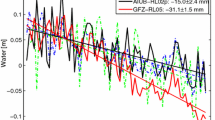Abstract
A spatiospectral localization method is discussed for processing the global geopotential coefficients from satellite mission data to investigate time-variable gravity. The time-variable mass variation signal usually appears associated with a particular geographical area yielding inherently regional structure, while the dependence of the satellite gravity errors on a geographical region is not so evident. The proposed localization amplifies the signal-to-noise ratio of the (non-stationary) time-variable signals in the geopotential coefficient estimates by localizing the global coefficients to the area where the signal is expected to be largest. The results based on localization of the global satellite gravity coefficients such as Gravity Recovery And Climate Experiment (GRACE) and Gravity and Ocean Circulation Explorer (GOCE) indicate that the coseismic deformation caused by great earthquakes such as the 2004 Sumatra–Andaman earthquake can be detected by the low-low tracking and the gradiometer data within the bandwidths of spherical degrees 15–30 and 25–100, respectively. However, the detection of terrestrial water storage variation by GOCE gradiometer is equivocal even after localization.
Similar content being viewed by others
References
Alenia (2001) Performance requirements and budgets for the gradiometric mission. Technical note G0-TN-AI-0027, Turin, Italy
Chambers D, Wahr J and Nerem R (2004). Preliminary observations of global ocean mass with GRACE. Geophys Res Lett 31: L13310. doi:10.1029/2004GL020461
Dahlen FA and Tromp J (1998). Theoretical global seismology. Princeton University Press, Princeton
Davis JL, Elosegui P, Mitrovica JX and Tamisiea ME (2004). Climate-driven deformation of the solid Earth from GRACE and GPS. Geophys Res Lett 31: L24605. doi:10.1029/2004GL021435
Ditmar P, Klees R (2002) A method to compute the Earth’s gravity field from SGG/SST data to be acquired by the GOCE satellite. Delft University Press
Ditmar P, Klees R and Kostenko F (2003). Fast and accurate computation of spherical harmonic coefficients from satellite gravity gradiometry data. J Geod 76: 690–705
Driscoll JR and Healy DM (1994). Computing Fourier transforms and convolutions on the 2-sphere. Adv Appl Math 15: 202–250
ESA (1999) Gravity field and steady-state ocean circulation mission. Rep. SP-1233, European Space Agency, Noordwijk
Fan Y andel Dool H, Mitchell K, and Lohmann D (2003). A 51-year reanalysis of the U.S. land–Surface hydrology. GEWEX News 13: 6–10
Gross RS, Chao BF (2001) The gravitational signature of earthquakes. In: Gravity, geoid and geodynamics: GGG2000 IAG international symposium, 2000, vol 123, pp 205–210. Springer, New York
Gross RS and Chao BF (2006). The rotational and gravitational signature of the December 26, 2004 Sumatran earthquake. Surv Geophy 27(6): 615–632
Han SC, Jekeli C and Shum CK (2004). Time-variable aliasing effects of ocean tides, atmosphere, and continental water mass on monthly mean GRACE gravity field. J Geophys Res 109: B04403. doi:10.1029/2003JB002501
Han SC, Shum CK, Jekeli C, Kuo C, Wilson CR and Seo KW (2005). Non-isotropic filtering of GRACE temporal gravity for geophysical signal enhancement. Geophy J Int 163: 18–25
Han SC, Shum CK, Bevis MG, Ji C and Kuo C (2006). Crustal dilatation observed by GRACE after the 2004 Sumatra–Andaman earthquake. Science 313: 658–662
Han SC, Simons FJ (2007) Spatiospectral localization of global geopotential fields from GRACE reveals the coseismic gravity change due to the 2004 Sumatra-Andaman earthquake. J Geophys Res (in-press)
Kaula WM (1967). Geophysical implications of satellite determinations of the Earth’s gravitational field. Space Sci Rev 7: 769–794
Kusche J (2007) Approximate decorrelation and non-isotropic smoothing of time-variable GRACE-type gravity field models. J Geod (in-press)
Luthcke SB, Zwally HJ, Abdalati W, Rowlands DD, Ray RD, Nerem RS, Lemoine FG, McCarthy JJ and Chinn DS (2006). Recent Greenland ice mass loss by drainage system from satellite gravity observations.. science 314: 1286–1289. doi:10.1126/science.1130776
Simons M, Solomon S and Hager B (1997). Localization of gravity and topography: constraints on the tectonics and mantle dynamics of Venus. Geophys J Int 131: 24–44
Simons M and Hager B (1997). Localization of the gravity field and the signature of glacial rebound. Nature 390: 500–504
Sun W and Okubo S (2004). Coseismic deformations detectable by satellite gravity missions: a case study of Alaska (1964, 2002) and Hokkaido (2003) earthquakes in the spectral domain. J Geophys Res 109: B04405. doi:10.1029/2003JB002554
Swenson S and Wahr J (2006). Post-processing removal of correlated errors in GRACE data. Geophy Res Lett 33: L08402. doi:10.1029/2005GL025285
Tamisiea ME, Mitrovica JX and Davis JL (2007). GRACE gravity data constrain ancient ice geometries and continental dynamics over Laurentia. Science 316: 881–883
Tapley BD, Bettadpur S, Watkins M, Reigber C (2004a) The gravity recovery and climate experiment: Mission overview and early results. Geophy Res Lett, Vol 31. doi:10.1029/2004GL019920
Tapley BD, Bettadpur S, Ries J, Thompson P and Watkins M (2004). GRACE measurements of mass variability in the earth system. Science 305: 503–505
Wahr J, Swenson S and Velicogna I (2006). Accuracy of GRACE mass estimates. Geophys Res Lett 33: L06401. doi:10.1029/2005GL025305
Wieczorek MA (2007). The gravity and topography of the terrestrial planets. In: Spohn, T (eds) Treatise on geophysics. vol 10. Planets and Moons, pp. Elesevier, Amsterdam
Wieczorek MA and Simons FJ (2005). Localized spectral analysis on the sphere. Geophys J Int 162: 655–675. doi:10.1111/j.1365-246X.2005.02687.x
Wieczorek MA, Simons FJ (2007) Minimum-variance multitaper spectral estimation on the sphere. J Fourier Anal Appl (in press)
Author information
Authors and Affiliations
Corresponding author
Rights and permissions
About this article
Cite this article
Han, SC., Ditmar, P. Localized spectral analysis of global satellite gravity fields for recovering time-variable mass redistributions. J Geod 82, 423–430 (2008). https://doi.org/10.1007/s00190-007-0194-5
Received:
Accepted:
Published:
Issue Date:
DOI: https://doi.org/10.1007/s00190-007-0194-5




